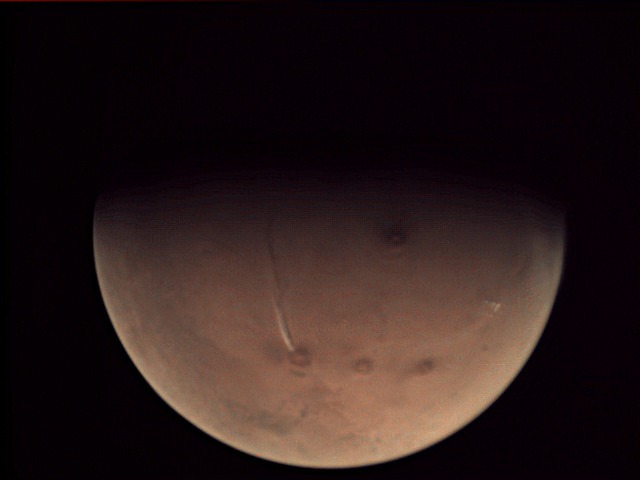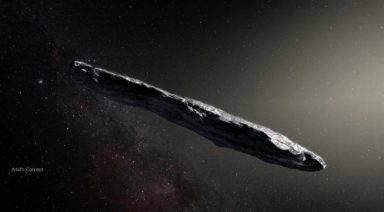Alleged Volcanic Eruption on Mars Sparks NASA Cover-Up Conspiracy

Conspiracy and speculation erupted across the internet yesterday over an alleged volcanic plume stretching roughly 1,200 miles across the Martian atmosphere. The plume appears to originate from the planet’s supposedly dormant Arsia Mons volcano.
Images of the activity were taken on Sept. 24 by the Mars Express orbiter and later published by the European Space Agency.
According to NASA, volcanic activity on the red planet ceased some 50 million years ago after Earth’s Cretaceous-Paleogene event that killed off the dinosaurs, but some believe this latest imaging shows otherwise.
Spurred by conjecture from a popular YouTube conspiracy channel, claims of volcanic activity on Mars reignited theories of government cover-ups and strange happenings within NASA, the FBI and other controversial government agencies.
Many are pointing to last month’s Sunspot National Observatory shutdown, the switch to a limited “safe mode” on the Hubble and Chandra telescopes, and the sudden failure of NASA’s Mars Curiosity Rover as evidence that strange events occurring on the planet may be intentionally obfuscated.
Arsia Mons is located within a tightly situated line of volcanoes on Mars, collectively known as Tharsis Montes, which lie in the shadow of Olympus Mons – the largest volcano in our solar system (more than twice the size of Mt. Everest).
Arsia Mons happens to be the planet’s second largest volcano in terms of volume and is home to a series of caves NASA has studied as the best places to situate research and habitation modules. Could there be something already underway?
“This project developed a revolutionary system to exploit the novel idea of extraterrestrial cave use” stated a project summary published in 2004, further explaining that two “missions” were tested to gather data.
Arsia Mons is known to have an annual whether phenomenon in which sunlight warms the area around the volcano, bringing small amounts of dust into the air. Rising air currents bring this dust and other fine sediment above the volcano’s caldera into a thick, spiraling cloud that is big enough to be seen by a probe orbiting the planet.

But the latest plume looks nothing like the spiraling cloud recorded from this phenomenon in the past. Instead it appears as more of a streaking trail that’s persisted over the course of weeks.
NASA has attributed the plume to water ice clouds that are gathering over the volcano. The agency says that at certain times of year, the small amounts of water in the atmosphere freeze and condense near areas of high altitude, notably above this volcanic region.
If this is the case, then maybe there’s significantly more water on the red planet than previously believed and we should study the areas it’s sublimating from.
But then again, there’s always some simple explanation from NASA that seems to make everyone’s concerns seem trivial. Is this really just a storm or are they covering up something far greater?
For more on the drips of disclosure coming from NASA’s Mars operations, check out this episode of Deep Space:
Nemesis Star Theory; Does the Sun Have an Evil Twin?

Many people remain anxious about the threat posed from a hidden nemesis planet, known as Nibiru, that has been prophesied to collide with Earth. Though many of the proposed dates for this collision have come and gone, there is another celestial body that may be more likely to lead to an apocalyptic event: The Nemesis Star.
The Nemesis Star Theory
Binary star systems occur frequently and are actually more common than single stars. At least that’s what we thought, until a recent hypothesis proposed the possibility that every star starts out as a binary pair or multi-pair system. While the theory hasn’t been confirmed, there is significant evidence that our Sun likely has a twin, an evil twin.
The majority of stars in the galaxy are red dwarfs, which are a fifth of the size of the sun and up to 50 times fainter. These types of stars are pretty commonly paired with another star in a binary system, leading astronomers to believe that Nemesis would be the Sun’s red dwarf star companion. But due to the small size and faintness of these stars, they can be hard to find, making Nemesis all the more elusive.

binary stars courtesy wired.com
This star is thought to be responsible for 12 cyclical extinction events on Earth, including the one that killed the dinosaurs. The Nemesis Star Theory’s roots can be traced to two paleontologists, David Raup and Jack Sepkoski, who noticed that there was a periodicity to major die-outs throughout Earth’s history, occurring in 26 million year intervals. This led to a number of astrophysicists and astronomers, postulating their own Nemesis Star hypotheses.
So how would the sun’s twin be responsible for mass extinctions? The Nemesis Star Theory proposed the idea that the Earth’s binary twin must be in a large 1.5 light-year orbit, retaining just enough gravitational pull between it and the Sun so as not to drift off. But the issue with the orbit of Nemesis is the possibility that it occasionally passes through a cloud of icy debris on the fringe of our solar system, known as the Oort Cloud.
Don’t Perturb the Oort
The Oort Cloud is a theoretical sphere that is believed to orbit our solar system, consisting of planetesimals, the small icy building blocks of planets, comets, and asteroids. These planetesimals are sticky and collide with each other until they become large enough to have a significant gravitational pull, eventually becoming as large as a moon or a planet. They also create asteroids and comets which can be knocked out of orbit and sent hurtling toward the center of the solar system, crashing into planets.
There is a binary star system that once passed close enough to nearly perturb the Oort, and it was likely visible from Earth. Scholz’s Star made a flyby some 70,000 years ago, at a distance of 50,000 astronomical units (AU), with one AU being the distance from Earth to the Sun. The Oort is thought to extend from anywhere between 5,000 and 100,000 AUs and is believed to contain up to two trillion celestial objects. Astronomers are 95% certain that Shulz’s star passed within half of a light-year of us, possibly perturbing the Oort, though apparently not enough to cause a mass extinction event.
Comets are believed to exist within the Oort and are the product of a thief model, a give-and-take of celestial bodies between stars when they’re formed. In this process, comets get pulled back and forth between the gravitational field of stars. It was for this reason that the Oort was theorized, due to the number of comets coming from it, there had to have been a sibling star that pulled them out to the Oort.

The Oort courtesy of space-facts.com
Astronomers also found a dwarf planet in the Kuiper Belt, a region just before the Oort that also contains icy, celestial bodies. This planet, named Sedna, orbits the Sun in a long, drawn-out elliptical path and is one of potentially hundreds. Sedna may help to explain the Nemesis star theory, in that its far-flung orbit was likely caused by our Sun’s twin, pulling it out as it drifted off into the depths of space. Imagine if instead of 9 planets in our solar system, there were a few hundred?
So where is this Nemesis star? Several years ago, the E.U. launched the wonderfully named, Gaia satellite, to map out the stars in the Milky Way and look specifically at stars that have had a close encounter with our solar system or that might come close in the future. But whether or not Nemesis will be found is unknown; it’s possible that it could make a return for the next mass extinction, or it is possible that it drifted off, perturbing the Oort of another star.




































